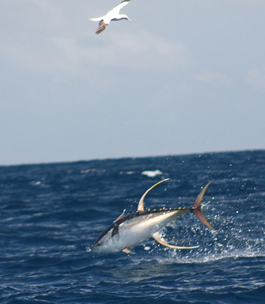OVERVIEW
Yellowfin tuna are found in tropical and subtropical oceans around the world. They’re highly migratory, capable of swimming across an entire ocean (and across international borders). Unlike non-migratory species that are only found off our coasts, we’re not the only ones fishing for yellowfin tuna. Fisheries for these species require both strong domestic management and international cooperation to ensure the resource is abundant and global harvests are sustainable. The United States is an active member of the International Commission for the Conservation of Atlantic Tunas (ICCAT) and negotiates with other member nations to enhance international management of yellowfin tuna (along with other tunas, billfish, and sharks).
Yellowfin tuna is the top tropical tuna harvested by U.S. fishermen in the Atlantic. More than half of this catch comes from our longline fisheries, which operate in the northwest Atlantic, Gulf of Mexico, and Caribbean. Longlines are often negatively portrayed for their potential to unintentionally catch sea turtles and marine mammals. However, in U.S. longline fisheries, fishermen abide by a number of measures that reduce the fisheries’ impacts on other species. These measures include mandatory use of special hooks and baits to reduce bycatch of depleted bluefin tuna, billfish, and sea turtles. When fishermen do accidentally hook a protected species, they carry gear and are trained in handling techniques to dehook species and safely return them to the water. Scientists and managers regularly monitor bycatch in these fisheries and review data for appropriate action as necessary, ensuring U.S. fishermen continue to responsibly harvest yellowfin tuna. U.S. fishermen also harvest yellowfin tuna in similarly highly regulated fisheries in the Pacific (see Pacific yellowfin tuna).






